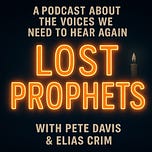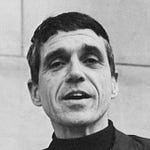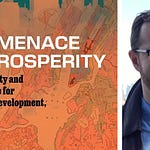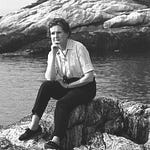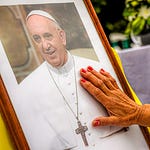His Buddhist community called him simply “Thay,” the Vietnamese word for teacher.
Zen Buddhist monk Thich Nhat Hanh died at age 95 in his native Vietnam, having endured 39 years of exile between 1966 and 2005. In his lifetime he became a global spokesperson for non-violence and peace, beginning with his missions to the U.S. in the early 1960s that aimed to halt the destruction of his country as the war in Vietnam continued to escalate.
Born in 1926, Nhat Hanh grew up in a time of French colonialism followed by American occupation and war. Thomas Merton, meeting him at his Gethsemani monastery in Kentucky, said he felt as though he had met Vietnam itself. He asked his gentle guest, “What is the war like?” Nhat Hanh replied, “Everything is destroyed,” the answer of a monk, as Merton later noted: no words wasted.
The Buddhist monk and the Cistercian monk: they seemed to embody, each in his own tradition, the interplay of action and contemplation, even the possibility that the taking up of new religious practices need not mean giving up the old ones.
Nhat Hanh’s engaged Buddhism resembled Merton’s later spirituality in its three components: contemplative practice, social action, and inter-religious dialogue. With his Order of Interbeing, established in 1966, he showed a path of non-attachment to all ideologies and real connection to the earth.
In addition to his writing and activism, Nhat Hanh established monasteries in Southern California, New York, Vietnam, Mississippi, Paris, Germany and Australia. His global ethic, including his mindfulness trainings, were highlighted by the United Nations for its non-sectarian ethical path for humanity.
Later in the episode, we are joined by Brother Phap Luu of the Deer Park Monastery, who received the Lamp Transmission from Nhat Hanh to become a Dharma Teacher in 2011 — and has been active in the Wake Up movement, which shares mindfulness practice with young people around the world.
Key Takeaways from our Conversation:
Nhat Hanh’s similarities to Abraham Joshua Heschel and Martin Luther King Jr.
His several connections to the “web” of the Beloved Community of our Lost Prophets
Early training as a monk and his ideas on a new form of “engaged” Buddhism which always saw Vietnam as one country
The Buddhist pagoda culture of good work and merit
He introduces himself to Martin Luther King Jr. in a letter attempting to explain the real meaning of the widely publicized self-immolation of a Buddhist monk in Saigon—i.e., it should be seen as an act of deliberate martyrdom over religious repression rather than a mere act of suicide.
In the 1960s, he was a leader in the difficult struggle between non-Communist nationalism and anti-Communist ideology, taking a non-dualistic approach.
“His ideas for peace, if applied, would build a monument to ecumenism, to world brotherhood, to humanity.” (Martin Luther King Jr., nominating Thay for the Nobel Peace Prize in 1967.)
The Beloved Community: a concept going back to Josiah Royce, then to A.J. Muste and Howard Thurman (King’s inspiration), it describes a society characterized by peace, justice, equality, and love, where all persons are valued and have the opportunity to thrive. Just as Nhat Hanh influenced King to speak out about the Vietnam War, King shared his understanding of the Beloved Community when they met in Geneva in 1967. Nhat Hanh then extends the vision by suggesting that not only deities but all beings might attain the status of boddhisattvas (enlightened beings who awaken others).
“Sitting is only one part of Zen…” (Fragrant Palm Leaves)
In 1970, with the help of the Fellowship of Reconciliation, Nhat Hanh founds Dai Dong, a Buddhist movement for the health of the earth. Its founding statement is signed by thousands of scientists and policy professionals. Several meetings between Nhat Hanh and U.N Secretary General U Thant lead to the first U.N. Climate Summit in Stockholm (1972).
“In order to save the world, each of us has to build a pagoda, a sanctuary where you have a chance to be alone and to face yourself, the reality of yourself.” (The Raft Is Not the Shore)
“If you have to choose between Buddhism and peace, then you must choose peace. Because if you choose Buddhism, you sacrifice peace—and Buddhism does not accept that.” (The Raft Is Not the Shore)
“…If you are not transformed on the way, you remain at the point of departure all the time; you never arrive at the destination. So the way must be in you; the destination must also be in you and not somewhere else in space or time.” (The Raft Is Not the Shore)
Mindfulness: In Buddhism, it is closely intertwined with interbeing. The energy of being aware and awake of the present moment. A better term, perhaps: remindfulness, emphasizing the root meaning of sati, closer to remembrance. It is at the same time a means and an end, the seed and the fruit. It is not merely a tool but a path.
Practice smiling—especially the Buddha’s half-smile.
In Buddhism, at least four persons practicing together are needed to be called a sangha (community). “Without a sangha, you will be lost.” (Living Buddha, Living Christ)
Recommended:
“A Cloud Never Dies” (documentary film)
Fragrant Palm Leaves, Journals 1962-1966, Thich Nhat Hanh
Lotus in a Sea of Fire (1967), Thich Nhat Hanh
Brothers in the Beloved Community: The Friendship of Thich Nhat Hanh and Martin Luther King Jr. (2021), Marc Andrus
The Miracle of Mindfulness: An Introduction to the Practice of Meditation (1975), Thich Nhat Hanh
The Raft Is Not the Shore (2001), Thich Nhat Hanh, Fr. Daniel Berrigan
Living Buddha, Living Christ (1995, 2007), Thich Nhat Hanh
Eyes of Compassion: Learning from Thich Nhat Hanh (2021), Jim Forest
Walk With Me (documentary film, 2017)
Many thanks to the great band NOBLE DUST, who provides the music for Lost Prophets. Their latest album, A Picture for a Frame, is here.
Many thanks to the great Dan Thorn, who helped edit this episode.
LOST PROPHETS is a podcast about the mid-century voices of solidarity we need to hear again. To listen on your podcast player, our Spotify link is here, Apple Podcasts link is here, and RSS link is here.


